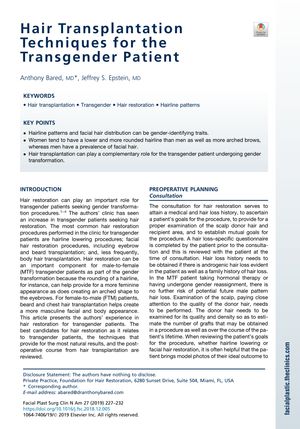Hair Transplantation Techniques for the Transgender Patient
March 2019
in “
Facial Plastic Surgery Clinics of North America
”
hair transplantation transgender patients natural-looking hairlines facial hair restoration eyebrows beards body hair transplantation follicular unit extraction FUE strip method donor hair harvest hairline lowering beard transplantation crossed-hatch pattern eyebrow transplantation chest hair transplantation pubic hair transplantation hair transplant

TLDR Hair transplantation can help transgender patients affirm their gender identity.
The document from 2019 outlines hair transplantation techniques for transgender patients, focusing on achieving natural-looking hairlines and facial hair that correspond with the patient's gender identity. It describes the preoperative planning, design process, and surgical procedures, including hairline lowering, facial hair restoration for eyebrows and beards, and body hair transplantation. Techniques such as follicular unit extraction (FUE) and the strip method are used for donor hair harvest. The document highlights the importance of patient involvement in the design process, natural results, and postoperative care but does not provide data on patient outcomes. Specifics include the challenges of creating density in beard transplantation, especially in the mustache and cupid's bow area, and the use of a crossed-hatch pattern for eyebrow transplantation, with a typical procedure involving 150 to 400 grafts per eyebrow. Chest and pubic hair transplantation are also mentioned, with 1800 to 3000 grafts and 400 to 900 grafts respectively, to create a masculine appearance and conceal scars. The document concludes that hair transplantation can significantly satisfy transgender patients' desires to affirm their gender identity.





